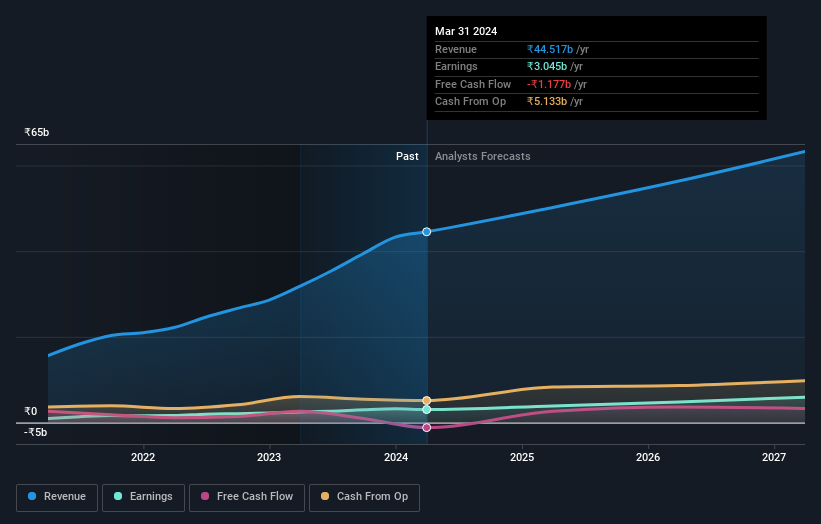Following recent decline, Craftsman Automation Limited's (NSE:CRAFTSMAN) top shareholder CEO Srinivasan Ravi sees holdings value drop by 7.6%
Key Insights
- Craftsman Automation's significant insider ownership suggests inherent interests in company's expansion
- The top 2 shareholders own 53% of the company
- Institutions own 25% of Craftsman Automation
If you want to know who really controls Craftsman Automation Limited (NSE:CRAFTSMAN), then you'll have to look at the makeup of its share registry. The group holding the most number of shares in the company, around 49% to be precise, is individual insiders. Put another way, the group faces the maximum upside potential (or downside risk).
And following last week's 7.6% decline in share price, insiders suffered the most losses.
Let's take a closer look to see what the different types of shareholders can tell us about Craftsman Automation.
View our latest analysis for Craftsman Automation

What Does The Institutional Ownership Tell Us About Craftsman Automation?
Many institutions measure their performance against an index that approximates the local market. So they usually pay more attention to companies that are included in major indices.
We can see that Craftsman Automation does have institutional investors; and they hold a good portion of the company's stock. This implies the analysts working for those institutions have looked at the stock and they like it. But just like anyone else, they could be wrong. It is not uncommon to see a big share price drop if two large institutional investors try to sell out of a stock at the same time. So it is worth checking the past earnings trajectory of Craftsman Automation, (below). Of course, keep in mind that there are other factors to consider, too.

We note that hedge funds don't have a meaningful investment in Craftsman Automation. The company's CEO Srinivasan Ravi is the largest shareholder with 49% of shares outstanding. In comparison, the second and third largest shareholders hold about 4.2% and 3.0% of the stock.
To make our study more interesting, we found that the top 2 shareholders have a majority ownership in the company, meaning that they are powerful enough to influence the decisions of the company.
While studying institutional ownership for a company can add value to your research, it is also a good practice to research analyst recommendations to get a deeper understand of a stock's expected performance. There are a reasonable number of analysts covering the stock, so it might be useful to find out their aggregate view on the future.
Insider Ownership Of Craftsman Automation
The definition of an insider can differ slightly between different countries, but members of the board of directors always count. Company management run the business, but the CEO will answer to the board, even if he or she is a member of it.
Insider ownership is positive when it signals leadership are thinking like the true owners of the company. However, high insider ownership can also give immense power to a small group within the company. This can be negative in some circumstances.
Our most recent data indicates that insiders own a reasonable proportion of Craftsman Automation Limited. It is very interesting to see that insiders have a meaningful ₹61b stake in this ₹125b business. Most would be pleased to see the board is investing alongside them. You may wish to access this free chart showing recent trading by insiders.
General Public Ownership
With a 26% ownership, the general public, mostly comprising of individual investors, have some degree of sway over Craftsman Automation. While this group can't necessarily call the shots, it can certainly have a real influence on how the company is run.
Next Steps:
While it is well worth considering the different groups that own a company, there are other factors that are even more important. For instance, we've identified 2 warning signs for Craftsman Automation that you should be aware of.
If you would prefer discover what analysts are predicting in terms of future growth, do not miss this free report on analyst forecasts.
NB: Figures in this article are calculated using data from the last twelve months, which refer to the 12-month period ending on the last date of the month the financial statement is dated. This may not be consistent with full year annual report figures.
New: AI Stock Screener & Alerts
Our new AI Stock Screener scans the market every day to uncover opportunities.
• Dividend Powerhouses (3%+ Yield)
• Undervalued Small Caps with Insider Buying
• High growth Tech and AI Companies
Or build your own from over 50 metrics.
Have feedback on this article? Concerned about the content? Get in touch with us directly. Alternatively, email editorial-team (at) simplywallst.com.
This article by Simply Wall St is general in nature. We provide commentary based on historical data and analyst forecasts only using an unbiased methodology and our articles are not intended to be financial advice. It does not constitute a recommendation to buy or sell any stock, and does not take account of your objectives, or your financial situation. We aim to bring you long-term focused analysis driven by fundamental data. Note that our analysis may not factor in the latest price-sensitive company announcements or qualitative material. Simply Wall St has no position in any stocks mentioned.
Have feedback on this article? Concerned about the content? Get in touch with us directly. Alternatively, email editorial-team@simplywallst.com
About NSEI:CRAFTSMAN
Reasonable growth potential with mediocre balance sheet.
Similar Companies
Market Insights
Community Narratives




